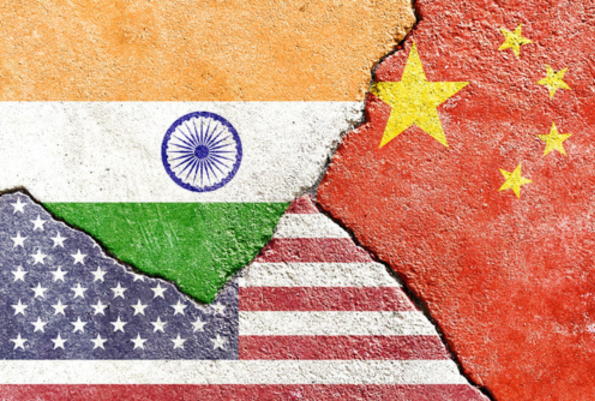The U.S. is cozying up to India partly in response to tensions with China. But no one in Washington, D.C., is quite sure how the new friendliness with Delhi will work out and what values will have to be tossed aside to make the relationship work.
Days after U.S. Secretary of State Anthony Blinken returned from Beijing, President Joe Biden hosted Prime Minister Modi with a glossy state visit at the end of June. Protesters showed their support and disapproval of the controversial Indian leader on the streets of Washington, D.C., and New York City.
The only time China was overtly mentioned was when, in response to a question, Biden told a reporter, “Secretary Blinken had a great trip to China. I expect to be meeting with President Xi sometime in the future, in the near term.”
Days after Modi left, leaders of the House Armed Services Committee met with Taiwan President Tsai Ing-wen (蔡英文 Cài Yīngwén) in Taipei. On July 3, the U.S. Embassy in Beijing issued a travel advisory to U.S. citizens, warning them to “reconsider travel due to the arbitrary enforcement of local laws, including in relation to exit bans, and the risk of wrongful detentions.”
Last week, Treasury Secretary Janet Yellen landed in Beijing for her long-awaited trip to China, reportedly to discuss national security and human rights issues, a “healthy” Chinese-U.S. economic relationship, and cooperation around climate change and debt distress.
This week, John Kerry, Special Presidential Envoy for Climate, will also travel to Beijing to meet with his counterpart, Xiè Zhènhuá 解振华, while President Biden, Secretary Blinken, and other senior U.S. officials meet with allies at the NATO Summit in Vilnius, Lithuania.
Modi’s trip in the middle of this fresh D.C.-Beijing shuttle diplomacy was either serendipitous timing or shrewd planning.
Compromising values for national security?
A week after Modi’s honorific second time addressing a joint session of Congress, the Asia Society Policy Institute held an intimate roundtable about the “U.S. Congress, Taiwan, and U.S.-China Strategic Competition.”
“As we get into [election] session, you’ll begin to see a race on who can be tougher on China,” University of Pennsylvania Law School professor Jacques deLisle told a dozen China-watchers sitting around a U-shaped table.
Afterward, I asked deLisle about his thoughts on Modi’s visit. He sighed. “Modi is tough, a particularly pointed example of U.S. national interests and foreign policy. We were able to duck it before. It’s part of the national security interest model of balancing values as a part of national interests.”
Later that day at an Asian policy-themed happy hour in DuPont Circle, young Washingtonians seemed apathetic about the controversial leader. The crowd of over 100 summer interns, grad students, and junior staffers in crisp suits and skirts buzzed about their travel experiences in Asia, their work (including whom their bosses were), and business between the U.S. and the region. A Google employee strolled around with a pitcher of margaritas.
When I asked the partygoers what they thought about Modi’s recent state visit, most sidestepped my question. Several told me that they didn’t know enough about India or Modi’s BJP Party. I prodded one international affairs graduate student, arguing that as an American taxpayer and voter, he helped fund the visit and would soon be asked whether to reelect President Biden. He told me that his vote didn’t count because he lives in Washington, D.C.
Calls for justice
Many members of the Indian-American diaspora felt aggrieved by Modi’s visit. Rasheed Ahmed, the executive director of the Indian American Muslim Council (IAMC), told me he was frustrated that the U.S. passively compromised values in the name of national security.
“I think the U.S. administration can encourage national interests to contain China and the U.S. can deal with India. That does not require providing a state dinner and giant session address,” he said.
Ahmed explained that the IAMC has worked to become a resource for “anyone who is interested in trying to understand the killing and rapes in Gujrat under then chief Minister Modi,” referring to the 2002 Hindu-led riots against local Muslims. In 2005, the U.S. imposed a visa ban on Modi. Those facts haven’t changed and he hasn’t been held accountable, Ahmed said.
To prepare for Modi’s visit, the IAMC collaborated with other India-centric organizations. They wrote letters to the White House and the State Department. They also recruited 75 members of Congress (all Democrats) to sign a letter to President Biden reaffirming the importance of India and the U.S.’s shared values and interests and highlighting evidence of India’s human rights abuses.
Democratic Representatives Rashida Tlaib (MI-12), Cori Bush (MO-01), Ilhan Omar (MN-05), and Jamaal Bowman (NY-16) boycotted Modi’s joint address to Congress. “Modi has a notorious and extensive record of human rights abuses. He was complicit in the 2002 Gujarat riots that killed over 1,000 people, leading to the revocation of his U.S. visa. His government has openly targeted Muslims and other religious minorities, enabled Hindu nationalist violence, undermined democracy, targeted journalists and dissidents, and suppressed criticism using authoritarian tactics like Internet shutdowns and censorship,” they wrote in a joint statement.
In front of the White House, I found a hawker playing music from a speaker and selling cold drinks to tourists. He told me that Modi’s visit attracted crowds, but wasn’t clear why. “The protesters last week asked me to turn down my music so they could speak, and then I lent them my speaker so they could be heard with a mic,” he told me. “I don’t know what they were saying — they were talking in their country’s language. But they had English signs that said the Indian government was bad.”
Across Pennsylvania Avenue in Lafayette Square, I found longtime activist Philipos Melaku-Bello sitting under a makeshift shelter covered with flags and signs championing human rights causes. He had more nuanced observations of the protests that accompanied the Indian prime minister’s visit.
“There were pro and against Modi. There were Sikhs, Muslims, Bahai, Buddhists, Christians, and atheists. There were some Hindu Indians that were standing up against Modi as well.”
The most common sign he saw was “You did not run to be the leader of Hindu, you ran to be the leader of India.” He was disappointed that, like many other protests he’s observed, like-minded ethnic groups didn’t seem to come together under a united umbrella.
Common interests over ideology
Raqib Hameed Naik, a Kashmiri-American journalist who researches India and Hindu nationalism and who has lived in China, made an argument more focused on interests than ideology. “India and the U.S. need each other, especially to go after China. But they need to ground the relationship on commonly shared values of human rights and justice.”
Naik argued that the Modi-led BJP government is pushing the country’s Hindu majority — 80% of the 1.4 billion population — to subjugate the 14% that identify with minority ethnic and religious groups. “Constant conflict could result in instability in the near future if this isn’t resolved at the earliest. An unstable India is not a good strategic ally for the U.S. against China.”
Indian voters, Naik said, are more swayed by anti-Muslim sentiments than anti-Chinese messages. “Everything comes back to politics at the end of the day and what will get votes. Modi, except once, has never even said the word China. Despite so much pressure from the [domestic] opposition to talk about the border issues with China, he’s not willing to.”
Enduring relationships
Akshobh Giridharadas, a visiting fellow at the Observer Research Foundation, a New Delhi-based think tank funded by multinational corporate philanthropies and family foundations, argued that Indian exasperation with China has been festering. Anti-Chinese sentiment in India, he said, began soon after India’s inaugural prime minister, Jawaharlal Nehru, formally recognized the P.R.C. as China’s legitimate government in 1950.
In 1959, after Tibetan refugees sought sanctuary in India, China’s then leader Máo Zédōng 毛泽东 responded with what ultimately became the 1962 Sino-Indian War. Anti-Chinese sentiments in India were further exacerbated during the 1971 Indo-Pakistani War, when the P.R.C. supported the Pakistani government.
“Even today, the Chinese support the Pakistanis so that the Indians have to spend more money on border security than their navy,” Giridharadas said.
He proudly told me about an event his organization hosted for Modi at the Kennedy Center during the state visit. “As India opened, so did the allure of India as a potential economic destination for American goods, manufacturers, and supply chains.”
Giridharadas further highlighted the growing influence of the Indian Diaspora. “The U.S.-India relationship is truly bipartisan, where we have had every combination of Democrat, Republican, BJP, and Congress administrations since U.S. President Clinton’s relationship with Indian Prime Minister Vajpayee.”
Surprising supporters
Steps from activist Philipos Melaku-Bello’s shelter on Pennsylvania Avenue, Seyfullah Abdukadir, an ethnic Uyghur, often demonstrates on behalf of the East Turkestan National Movement (ETNM). ETNM is a nonprofit registered in Washington, D.C., with offices in Edmonton, Canada, and Brussels, Belgium. It identifies itself as a government in exile and is dedicated to gaining independence for East Turk peoples in China (Uyghurs, Kazakhs, Kyrgyz, Uzbeks, and Tatars).
When I asked Abdukadir about the India-China relationship, he took issue with the question’s premise. “India is not bordered with China,” he said. “India is bordered by East Turkestan and Tibet. China invaded some Indian territory. Indian people have to be part of fighting against this genocide and invasion. The U.S. government needs to be part of it, too.”
Abdukadir defended India’s democratic identity. “India is hosting the G20. India is a big country, a democratic country. Democratic value is standing up for justice. India needs to be that.”
Salih Hudayar, the founder and president of the ETNM, echoed this sentiment. “We view Prime Minister Modi’s state visit to the U.S. very positively, as increased cooperation between India and the United States will serve as a shield against China’s aggressive push for global hegemony and supremacy,” he told me.
When I asked if he still supported the visit given accusations to Modi’s government about human rights abuses against Muslims that limit their rights and freedoms, he was steadfast. “What India’s government is doing cannot be compared with the genocide being committed by the Chinese government. The P.R.C.’s aim is to completely eradicate Turkic peoples in East Turkestan.”
Laurel Schwartz has been studying and working in China since 2002. Most recently, she was based in Beijing, where she was a Canadian Chinese school principal, serving students in grades K-12 during the pandemic. She is currently based in Washington, D.C.
Source: The China Project


